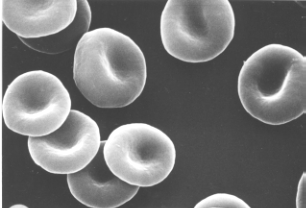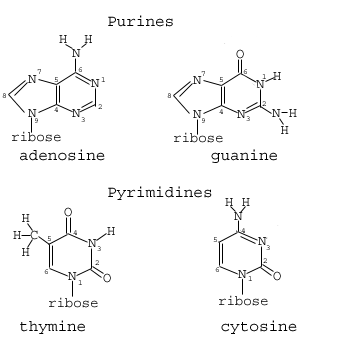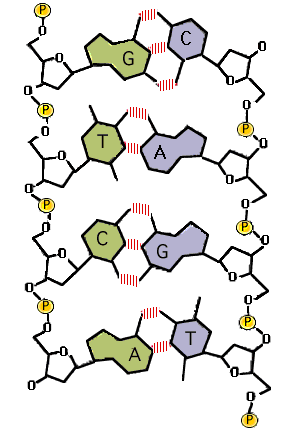
Preview
Material for Exam 3 - Fall 2006
Print
the PDF version (no pictures, better printing)
Use the following chart and formulas when needed.
mRNA-Codon-to-Amino-Acid Decoder Chart |
|||||||||
|
|
2nd Letter |
|
||||||
1st Letter |
U |
|
C |
|
A |
|
G |
|
3rd Letter |
U |
UUU |
Phenylalanine |
UCU |
Serine |
UAU |
Tyrosine |
UGU |
Cysteine |
U |
C |
|||||||||
UUA |
Leucine |
UAA |
STOP |
UGA |
STOP |
A |
|||
UGG |
Tryptophan |
G |
|||||||
C |
CUU |
Leucine |
CCU |
Proline |
CAU |
Histidine |
CGU |
Arginine |
U |
C |
|||||||||
CAA |
Glutamine |
A |
|||||||
G |
|||||||||
A |
AUU |
Isoleucine |
ACU |
Threonine |
AAU |
Asparagine |
AGU |
Serine |
U |
C |
|||||||||
AAA |
Lysine |
AGA |
Arginine |
A |
|||||
AUG |
Methionine; START |
G |
|||||||
G |
GUU |
Valine |
GCU |
Alanine |
GAU |
Aspartate |
GGU |
Glycine |
U |
C |
|||||||||
GAA |
Glutamate |
A |
|||||||
G |
|||||||||
r=b-d G=rN G=rN(K-N)/K

Dystonia is a neurological disorder characterized by uncontrollable muscle contractions/spasms. These contractions are often so intense they force arms, legs or fingers into abnormal positions. A new treatment for dystonia involves injecting small doses of purified Botulinum toxin (Botox) into affected muscles. The injections reduce extra muscle contractions but leave enough strength for normal use. Botulinum toxin is produced by the bacterium Clostridium botulinum. Some forms of dystonia are inherited as an autosomal dominant trait.
Botulinum toxin can harm as well as heal. The natural form of the bacterial toxin can paralyze and kill if consumed in a large enough dose in contaminated food. Once consumed the result is weakness and paralysis that descends from the head down through the body. The most damaging effect is to the muscles that allow breathing. Botulinum toxin is a protein. The following sequence comes from the middle of the gene that codes for the toxin: TAG GCA CGT TCG
Human red blood cells remain intact when the fluid surrounding them contains the same salt (NaCl) concentration as that found inside the cell, in other words, when they are placed in an isotonic solution. A student, Autumn, knew that for human red blood cells, an isotonic solution would be one that is 0.9% salt. She wanted to determine the salt concentrations that would result in the swelling and rupturing or the shriveling of the majority of cells in a sample. She obtained red blood cells from a local clinic, made the appropriate salt solutions, added 100 intact cells to each solution and then observed the cells using a microscope. Her data are presented below.

Percent NaCl |
1.2 |
1.1 |
1.0 |
0.9 |
0.8 |
0.7 |
0.6 |
Number of ruptured cells |
100 |
0 |
1 |
0 |
15 |
63 |
99 |
Number of shriveled cells |
0 |
98 |
71 |
0 |
0 |
1 |
0 |

Staphylococcal infections are caused by the bacterium Staphylococcus aureus that inhabits the skin and mucous membrane of the nose. It is spread by physical contact and droplets from the mouth and nose. MRSA is a term describing bacteria of S. aureus that are resistant to the antibiotic methicillin and other conventional antibiotics. MRSA infections may occur in surgical wounds, burns, catheter sites, eye, skin and blood. Symptoms include redness, swelling and tenderness at the site of infection. In the late 1940s, penicillin was very effective in the treatment of staphylococcal infections but resistance to this antibiotic drug emerged rapidly. Later, the antibiotic drug methicillin was introduced, but resistance to this antibiotic drug also developed very fast. At present, MRSA infections are very common in hospitals in the USA and other countries and the number of infections rises each year.
Methicillin
A small population of sea lions living on a small island off the Oregon Coast has been monitored for 4 years. A pod of killer whales (Orcas), known to prey upon sea lions, has taken up residence in the water surrounding this island. The island is 2 acres in size. The data collected is shown in the below table.

Year |
Population size at the beginning of the year |
Number of births |
Number of deaths |
2000 |
250 |
60 |
22 |
2001 |
288 |
No Data |
No Data |
2002 |
328 |
64 |
20 |
2003 |
372 |
72 |
25 |
2004 |
419 |
83 |
34 |


Bee stings hurt. Bee stings deliver a venom that causes pain when injected into the skin. The major component of the venom responsible for pain is a protein called melittin. The protein is composed of 26 amino acids. Melittin stimulates the nerve endings of the pain receptors in the skin. The immune system will recognize melittin and enhance the disposal of the protein. The amino acid sequence glycine-alanine-isoleucine-leucine is part of the amino acid sequence of the melittin protein.


